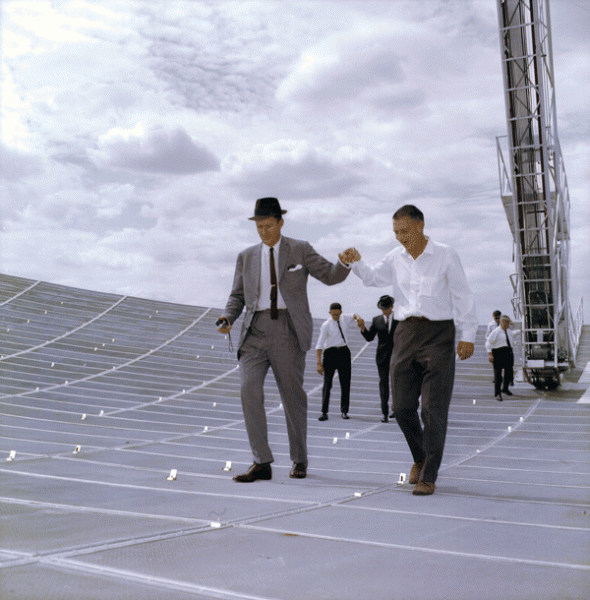Cumulus on the radar at CSIRO

As image asset management challenges go, they don’t get much bigger. Dr Jessica Chapman walked into a new role at the CSIRO Australia Telescope National Facility in 2000 to find that as part of her job she had been put in charge of an archive of 100,000 negatives documenting the history of radio astronomy from 1946 to 1996.
Australia has played a prominent role in the development of radioastronomy and space tracking, with its most famous moment coming during the 1969 Apollo 11 mission, when CSIRO's Parkes Radio Telescope in NSW received the television transmission of the Apollo 11 moonwalk, estimated to have been watched by six hundred million people worldwide.
Some of the early pioneers in the field of radio-astronomy worked in Australia after World War II. The first detection of extra-terrestrial radio emission took place in the early 1930s when a physicist called Karl Jansky, working for the US Bell Telephone Laboratories, detected radio ‘noise’ that he established comes from the plane of our Galaxy, the Milky Way.
CSIRO set up an ambitious radio astronomy program soon after the war to follow up on this emerging science and many exciting astronomy discoveries were made in the post-war years. Over the 50 year evolution of the science, as the early primitive antennas were replaced by more and more complicated radio telescopes and arrays, the CSIRO photographed and documented the people, facilities, technical developments and events at the heart of radioastronomy.

Most of the images were shot by dedicated photographers employed by the CSIRO, shooting on film. The photographic collection is a magnificent record of this history. Dr Chapman, who is now the Operations Research Program Leader at CSIRO Astronomy & Space Science and a practising radio-astronomer herself, recognised the value of this irreplaceable collection of images, but knew that something would have to be done to make it more accessible for historians and fellow researchers.
The first step was to relocate the formidable collection to a dedicated archive room with controlled temperature and humidity, to maintain the condition of the negatives. The negatives were transferred to acid-free sleeves to help preserve them. For future access and storage of a digital collection, the Cumulus Digital Asset Management (DAM) platform was selected from local distributor Databasics.
It was decided it would be impractical to scan and digitise the entire collection, so historian and professional archivist Dr Wayne Orchiston was employed to evaluate the 12000 sets of records, containing up to 100 negatives per set and to provide historical information and captions for some of the images.
Each set of negatives was stored in a plain envelope with information handwritten on the outside. The packet titles and numbers were diligently recorded by the photographers in handwritten logbooks.
In the late 1990s, a FileMaker database was constructed to capture the handwritten information given on each of the packets, and this was manually entered. This information provided the starting point for assessing the collection and the FileMaker database continues to be used to record information relating to the packets of negatives.
The archivist determined that about 65% of the collection was of historical significance. All of the original negatives are stored at CSIRO.
Each record was assigned a category (e.g. people, buildings, etc...). Since the assessment of the collection, around 16000 of the selected negatives have been scanned using a FleXtight Precision II scanner purchased for the task. This proved to be extremely well suited to the task, providing very high quality digitisation.
Each negative was scanned to a high resolution TIFF file at a resolution of around 10 megapixels (with files sizes ranging from 10MB for black and white or 30MB for colour).
Barnaby Norris, now a PhD student in Astronomy at the University of Sydney, was assigned the task of undertaking the scanning in-house. Barnaby, a keen photographer who has a Eureka photography prize to his credit, also undertook some image correction in Photoshop where necessary.
The arduous task of scanning 16000 images in the collection has now been completed, and CSIRO Astronomy and Space Science has recently updated its client-server version of Cumulus to the latest version 8.5.2, with a client-server licence for three Cumulus desktop workstations.
The image metadata and captions are fairly complete for the years 1946 to 1961. Further work to add metadata and captions for the full collection is continuing.
CSIRO makes the high resolution scanned images available to historians and researchers from research organisations in Australia and overseas.
The Cumulus Web access module could be used to make the catalogue more generally available via the Web or on the CSIRO intranet. Chapman would like to provide wider access to a broader audience and is looking at options for doing this. She would like to retain some control over the images once made available via the web to ensure that the stories are told accurately and that individuals are properly credited.
After the arduous task of scanning and cataloguing the massive image database, the thought of browsers skimming and utilising the images without acknowledging copyright is also a concern.

Whilst the historical image collection provides extensive information on people, facilities and events, Chapman notes that there is currently no central archive in Australia for scientific radio astronomy images though this would be well worthwhile. Science images in radio astronomy are typically generated by individuals and research teams and published in research journals. An example of a collection of radio astronomy images is available from the US National Radio Astronomy Observatory (NRAO) at images.nrao.edu/.
“The Cumulus archive we've set up is maintained by CASS and is not used for commercial purposes. The main catalogue provides a fantastic history archive with about 16,000 scanned photos showing the history of the Australia Telescope National Facility,” said Chapman.
“I think it would be fair to say that the archive we have generated is of national significance to the history of radio astronomy - which itself is one of Australia's great 'stories'. “
